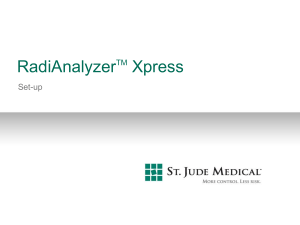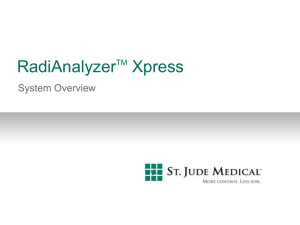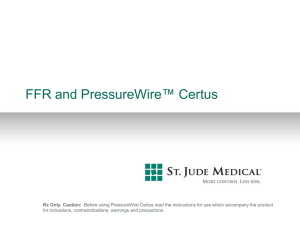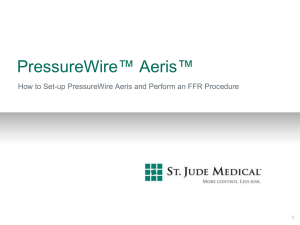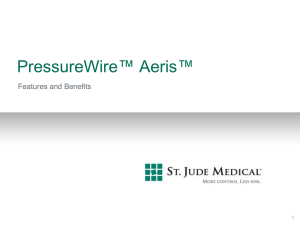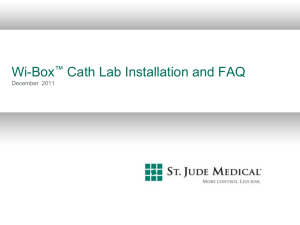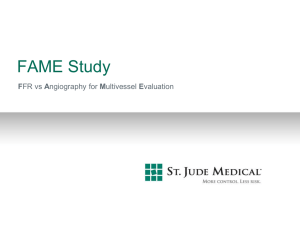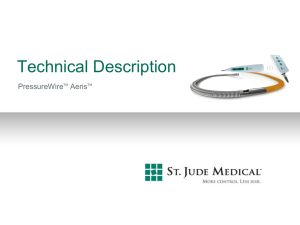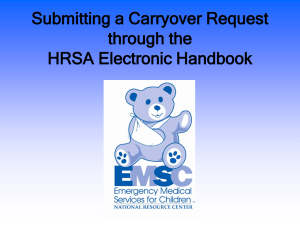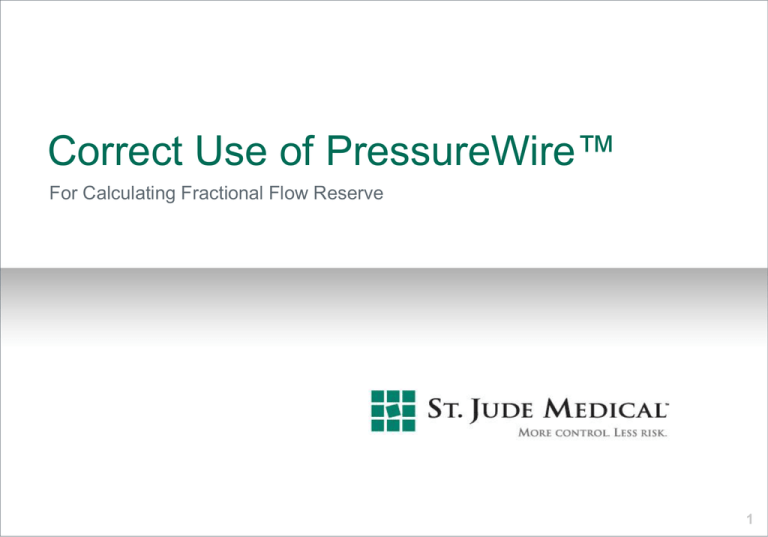
Correct Use of PressureWire™
For Calculating Fractional Flow Reserve
1
Module Content
2
Equipment for FFR Calculation
Overview PressureWire Certus
RadiAnalyzer Xpress
Hyperemia
Basic Set-up
Connect Cables
Automatic Set-Up sequence:
1. Zero Cath Lab
2. Zero AO
Before Proceeding to Step 3
3. Calibrate WIRE
Verifying Equal Pressures
Equalize
Record and Calculate FFR
Analyze Pressure Recordings
Verify Equal Pressures
Review Previous Recordings
Summary
Equipment for FFR Calculation
PressureWire
3
Hyperemia
RadiAnalyzerTM Xpress
PressureWireTM CertusTM - Overview
Multi-function sensor:
FFR, CFR, IMR
Hydrophilic coating
Hydrophobic connector
3cm
Polymer sleeve
PTFE coating
Entry funnel
4
PressureWire Certus
Detailed close-up
3 electrical cables
Core wire
Sensor element
5
Sensor
element
RadiAnalyzer Xpress - Overview
Keypad
Remote control
Front connector for
PressureWire
Remote receiver
& standby indicator
6
RadiAnalyzer Xpress
Remote control holder
Memory card cover
Equipotential pin
Communication ports
IV pole
screw
Power switch
AO IN
AO OUT
PressureWire OUT
7
Power supply
110/240V
Hyperemia
140
Hyperemia is a pre-requisite for FFR.
A high volume infusion pump is
required for I.V. administration of
hyperemic drugs
8
Basic Set-up
For ease of use, RadiAnalyzer Xpress
can be mounted on the cath lab table
rail
9
Connect Cables – Standard Set-up
1. Connect AO transducer to AO adapter cable
2. Connect AO adapter cable to AO IN port (red)
3. Connect AO OUT port (red) to cath lab recording system (P1)
4. Connect PressureWire OUT (green) to cath lab recording system (P2)
AO adapter cable
cath lab pressure input P1
cath lab pressure input P2
AO transducer
10
10
Connect Cables – NamicTM Adapter Cable
1. Disconnect the Namic® AO transducer from its monitor interface cable.
2. Connect the Namic AO transducer to the Namic adapter cable.
3. Connect the monitor cable to the Namic Adapter cable.
The Namic adapter cable should stay connected to RadiAnalyzer Xpress AO IN and AO OUT
11
11
Power On
After cables are connected,
switch RadiAnalyzer Xpress
to ON.
RadiAnalyzer Xpress will
perform a system check then
take you to the auto set-up
sequence screen.
12
Automatic Set-up Sequence
The automatic set-up sequence is a on-screen step-by-step guide that
runs through the three main set-up steps.
The sequence is enabled/disabled in the OPTIONS submenu.
If enabled the sequence starts automatically when the instrument is
turned on.
The sequence can be aborted by pressing ESC.
It is possible to advance/go back using LEFT and RIGHT buttons.
The sequence can always be started from the MAIN menu by keeping
F1 pressed for more than 2 seconds.
13
Auto Set-up Procedure
step 1: ZERO cath lab channels
”ZERO” both pressure channels on cath lab recording
system, press ENTER when done.
(Optional: Press LEFT/RIGHT to test AO/PressureWire OUT).
14
Auto Setup Procedure
step 2: ZERO AO
Open AO TRANSDUCER TO AIR and press ENTER.
Close valve to resume pressure reading.
15
Before Proceeding to Step 3
Prepare PressureWire
1.
2.
3.
4.
5.
16
Remove tray from sterile pouch using standard sterile technique
Place tray on cath lab table sterile dressing
Flush packaging coil with saline
Remove lid by pulling where indicated by arrow
Pull out instrument connector and connect to RadiAnalyzer Xpress, keep a finger on
the white proximal connector to avoid the wire sliding out of the coil
Auto Setup Procedure
step 3: Calibrate PressureWire
Place coil flat, and flush to fill the coil with saline.
Press ENTER.
17
PressureWire is Now
Calibrated and Ready for Use
18
Things to Remember When Handling
PressureWire
Avoid kinking when removing PressureWire from packaging coil
Do not damage sensor element when shaping tip
Tighten torque device properly so that it does not slip on wire shaft
Disconnect wire from white proximal connector for improved torque
Tighten proximal connector securely
Always keep PressureWire connectors dry
Wipe proximal 7 cm of wire clean, and dry before reconnecting
19
Verifying Equal Pressures
Advance sensor element just outside guide catheter opening.
Verify that AO (Pa) and PressureWire pressures are equal at this position.
Guide Catheter
PressureWire Sensor
20
Equalize
If pressures are NOT equal:
1. Position AO transducer at patient’s heart level.
2. Remove guidewire introducer needle and close valve tightly.
3. Flush any contrast remnants.
4. Press Equalize
button and hold for 3 seconds.
Any small pressure difference is removed electronically and will be
displayed on the monitor.
21
Equalize
22
Record and Calculate FFR
1. Advance sensor element distal to
the lesion site.
2. Wait for stable baseline pressure
values.
3. Induce maximum hyperemia.
4. Press REC to start recording.
5. When maximum hyperemia is
reached, press Stop/View to stop
recording.
The instrument then calculates
FFR automatically.
FFRmyo= Pd/Pa
At maximum hyperemia
23
Review Pressure Recordings
Use cursor to analyze recording.
Select CURSOR and press ENTER.
Move CURSOR with LEFT and RIGHT buttons.
Press ENTER to save new position and leave menu.
Press ESC to leave without saving position.
24
Verify Equal Pressures Post-Procedure
After procedure – verify equal AO and PressureWire pressures.
Withdraw PressureWire sensor so that the element is just outside the guide
catheter opening.
Verify that AO (Pa) and PressureWire (Pd) pressures are equal
(difference < 5 mmHg) at that position.
Guiding catheter
PressureWire sensor
25
Review Previous Recordings
Press STOP/VIEW
Select LIBRARY and press ENTER
Browse through recordings using PREV and NEXT.
26
Summary
FFR Measurement (1/2)
1. Verifiy equal signals when sensor is just outside the guide catheter
opening.
2. Advance wire; the sensor crosses the lesion.
3. Induce maximum hyperemia and measure FFR.
4. Because sensor is 3 cm from tip, easily pull-back and push-up for exact
spatial information.
If desirable, perform a pull-back recording.
27
Summary
FFR Measurement (2/2)
5. Perform PCI if indicated. If needed, perform optional wedge pressure
measurement for collateral flow assessment.
6. Repeat post PCI, FFR measurement to check result.
If desired, perform hyperemic pull-back recording.
7. Verify absence of drift at the end of procedure or between
measurements in several vessels.
28
RX Only
Product referenced is approved for CE Mark
Brief Summary: Prior to using these devices, please review the Instructions for Use for a
complete listing of indications, contraindications, warnings, precautions, potential adverse
events, and directions for use. The products are designed, developed and manufactured by St.
Jude Medical Systems AB. Unless otherwise noted, ™ indicates a registered or unregistered
trademark or service mark owned by, or licensed to, St. Jude Medical, Inc. or one of its
subsidiaries. PressureWire, Certus, Aeris, RadiAnalzyer, RadiView, RADI, ST. JUDE MEDICAL,
the nine-squares symbol, and MORE CONTROL. LESS RISK. are registered and unregistered
trademarks and service marks of St. Jude Medical, Inc. and its related companies.
Namic is a registered trademark of Navilyst Medical or its affiliates.
©2010 St. Jude Medical, Inc. All rights reserved.
29
This is the last page of this module.
30

